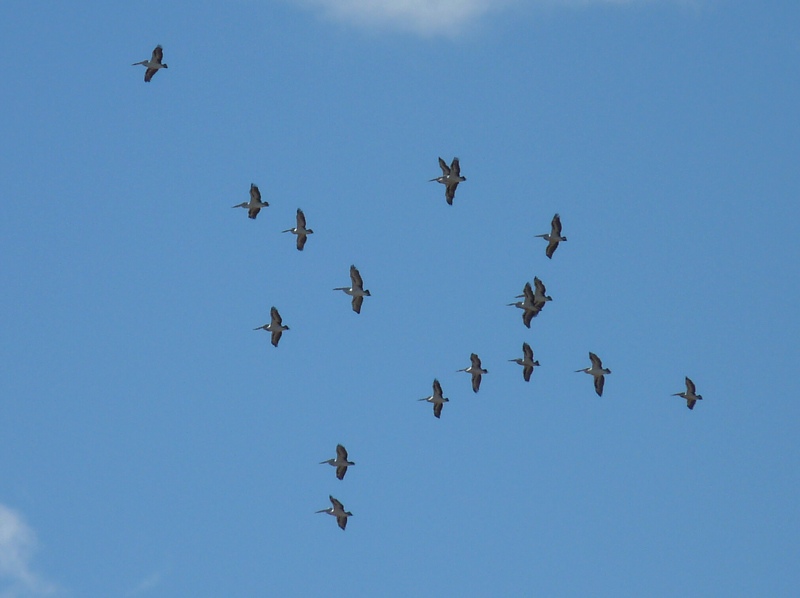
Pelicans are an excellent source of reflection in stressful times. Photo: Ian Fraser.
There is no disrespect intended in that title as there are some things no-one really knows about these familiar and wonderful birds.
Mary Hannay Foott brought our attention to one such mystery in her 1881 poem, Where the Pelican Builds, the reference being to some unknown utopia in inland Australia “where the pelican builds her nest”.
(Mary Black’s family came to Australia from Glasgow when she was a child. She later married Thomas Foott and they moved to Bourke, and then south-west Queensland. Following her husband’s death, she published a book of poems featuring Where the Pelican Builds and later wrote for newspapers. Foott Street in Garran is named after her.)
The strange fact is we understand almost nothing about where pelicans breed. The most authoritative accounts admit that Australian pelican breeding in general is ‘poorly known’, which is strange considering it is such a common and widespread bird.
There are scattered records from every state in Australia, although not the ACT. In NSW, these are sprinkled from the Riverina to the Darling to the North Coast, but every time was just a one-off event.
Most birds breed in the same area every year. However, pelican breeding colonies were established at Lake George in 1963 and 1968, with hundreds of nests, yet they didn’t produce a single chick.
It seems that essentially all Australian pelicans derive from only two breeding sites, just one of which is permanent. This rookery, on islands in the north of the Coorong, South Australia – Storm Boy country – produces all of Australia’s pelican chicks for almost any given year.
The other reliable, though very sporadic, source of baby pelicans is on various far-flung inland waterways of the Lake Eyre basin during rare flooding events. In 1990, around 100,000 pelicans (perhaps a third of all the pelicans in Australia) on Lake Eyre produced 80,000 to 90,000 chicks, which later dispersed throughout the continent, including Canberra’s lakes.
But how do they know where and when to go to meet at the rare distant floodwaters? We have no idea. Stories of detecting distant thunderstorms or barometric variations are fanciful – Lake Eyre generally fills from rains having fallen months earlier and thousands of kilometres away.
I wonder if experienced old birds are just constantly drifting across the land to check out the conditions; if they don’t come back, others go looking, too. However, that’s just speculation. Whatever the answer to that one, reliance on rare events for major population boosts suggests that pelicans must be long-lived. But as you’ve probably guessed by now, we don’t know that either.

Pelicans regularly cross the entire continent of Australia, riding rising air currents to save energy. Photo: Ian Fraser.
Another serious weirdness associated with pelican breeding concerns the well documented convulsions into which every single pelican chick goes after being fed. For about a minute it thrashes about, biting anything within reach, including itself. Then it collapses for about 30 seconds, before becoming ‘normal’ again.
If the chick is fed again afterwards, there is no reaction. If there are two chicks, only the larger ones does it. And yet again, we have no idea why. Suggestions of ‘exaggerated begging behaviour’ seem a bit lame. Mind you, if I were being fed fish that had been carried without being digested inside a hot pelican for some hours, I might convulse, too.
What about the stories of more unusual food sources, including small dogs? Well, yes and no. There are well-authenticated incidents of pelicans seizing and drowning annoying silver gulls, then eating them, and a much-cited case of a mother grey teal – a small native duck – and her entire brood vanishing down a pelican’s gullet.
But tales of chihuahuas and other little dogs going the same way seem to belong in the urban myth basket.
Next time you admire the pelicans on Lake Burley Griffin or at the coast, consider the journeys which brought them there. They may have hatched on the windswept Coorong or under a blazing Lake Eyre sun. In their lives, they may have travelled to Kakadu, Perth or Tasmania – or all three, and more – climbing high on rising hot air currents then drifting for tens or hundreds of kilometres without exerting any energy at all.
There is just so much we don’t know about pelicans, which is a healthy thing for us arrogant humans to contemplate. And now is a good time to think about something entirely different for a short while.












